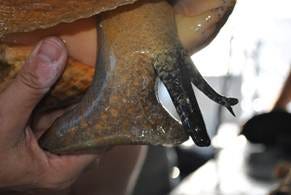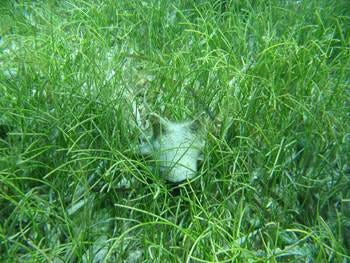Shedd Aquarium’s Queen Conch Study
A Holistic Approach to Counting an Endangered Marine Invertebrate
By Jordan Schaul | National Geographic | April 4, 2013
This, my second article highlighting current field research initiatives of Chicago’s Shedd Aquarium, is a look at one of the two most important fisheries in the Bahamian Archipelago—and efforts to address the decline of a shellfish population that has been harvested since Pre-Columbian times.
This, my second article highlighting current field research initiatives of Chicago’s Shedd Aquarium, is a look at one of the two most important fisheries in the Bahamian Archipelago—and efforts to address the decline of a shellfish population that has been harvested since Pre-Columbian times.
Dr. Alexander Tewfik, a post-doctoral fellow at Shedd’s Daniel P. Haerther Center for Conservation Research, has embarked on a three-year project to study Bahamian queen conch (Strombus gigas) populations using non-traditional surveys. He hopes the research will contribute to improved management and conservation of Queen conch that is vital to marine ecosystems and an array of human stakeholders.
I once owned a conch shell that I purchased as a souvenir while visiting Haiti on a vacation with my family. I was wholly unaware that the inanimate seashell was called a “conch” until I read Lord of the Flies. Even then, I probably mispronounced the word “conch”, which is supposed to be pronounced with a hard “K”, and more aptly used in reference to one of the six Caribbean region species of large marine gastropods and their shells. Lastly, I had no idea that I was helping deplete a population of a highly prized invertebrate species—the largest of the six species in this region— that is listed under CITES Appendix II (commercially threatened).
The marine snail and its shell are what really comprises this megagastropod in its entirety; however, sometimes the empty shell alone is referred to and colloquially better known as a conch, as it was in the book Lord of the Flies. It never occurred to me that a snail actually lived inside the shell until I took an elective high school course in invertebrate zoology. Perhaps you are more astute than I, but it would seem that most people, even avid beach-goers, are more familiar with the calcium carbonate shells than the muscular, fleshy part of the organism—which includes the part we call the mantle. The mantle, or outer epithelium of the snail’s living tissue, is what secretes the calcium carbonate and the protein conchiolin, which comprise the inner and outer layers of the shell.
Shells of the queen conch have been sold as decorative souvenirs, or curio, for many years, and the soft tissue of the snail has been a food source since pre-Columbian times. Since the mid-20th century, harvesting for expanding local populations, tourists and international export has increased pressure on populations of Queen conch throughout the region. Unfortunately, in the past few decades, the queen conch has been so overharvested that they are no longer abundant in shallow coastal waters where they once thrived. Hence, marine biologists and conservationists are quite concerned about the future of this marine snail and the wider natural community where it lives. In recognition of the decline of Queen conch populations and their cultural importance, the Government of the Bahamas, led by the Bahamas National Trust, has embarked on a Conch conservation campaign to be officially launched in Nassau on April 27th, 2013.
Herbivorous queen conchs indirectly manage seagrass ecosystems, eating dead grass and creating conditions that support broader biodiversity. Healthy seagrass beds provide important ecosystem services: they buffet the coast from storm waves, stabilize sand that might otherwise smother coral reefs, and support critical nursery and foraging habitat for lobsters and fish. Anyone who’s ever appreciated the beauty of a coral reef, whether in pictures or in person, actually owes a debt of gratitude to seagrasses and one of the principal animals, the Queen conch, which facilitates healthy beds: one cannot thrive without the other.
Fortunately, under the auspices of the Shedd, Dr. Tewfik has endeavored to take a new approach to understand the ecosystem-wide impacts that overharvesting conch may catalyze, in hopes of supporting sustainable management. Instead of counting conch along set transect lines (a significant effort being conducted by the NGO Community Conch and Shedd’s mutual partners the Bahamas National Trust and Bahamas Department of Marine Resources), the biologist plans to assess the abundance of other types of benthic consumers from specialized grazers to predatory snails such as helmet shells—themselves part of the curio trade- for a broader community perspective. He also plans to document the conditions of seagrass habitat so vital to Queen conch and associated biodiversity across the archipelago. In addition, Dr. Tewfik will assess whether juvenile and adult conch spillover from protected areas like Exuma Cays Land and Sea Park may help replenish adjacent fished areas.
According to the Shedd Aquarium, this holistic approach to resource management and conservation will provide significant input to adaptive management strategies for exploited species; the development of protected areas and/or fisheries reserves that enhance a broad set of species and habitats; and identify ecosystem conditions that no longer support sustainable harvests, high biodiversity, and healthy habitats.
ABOUT NATIONAL GEOGRAPHIC SOCIETY
The National Geographic Society is a global nonprofit organization that uses the power of science, exploration, education and storytelling to illuminate and protect the wonder of our world. Since 1888, National Geographic has pushed the boundaries of exploration, investing in bold people and transformative ideas, providing more than 14,000 grants for work across all seven continents, reaching 3 million students each year through education offerings, and engaging audiences around the globe through signature experiences, stories and content. To learn more, visit www.nationalgeographic.org or follow us on Instagram, Twitter and Facebook.
MEET THE AUTHOR
Jordan Carlton SchaulWith training in wildlife ecology, conservation medicine, and comparative psychology, Dr. Schaul's contributions to Nat Geo Voices have covered a range of environmental and social topics. He draws particular attention to the plight of imperiled species highlighting issues at the juncture or nexus of sorta situ wildlife conservation and applied animal welfare. Sorta situ conservation practices are comprised of scientific management and stewardship of animal populations ex situ (in captivity / 'in human care') and in situ (free-ranging / 'in nature'). He also has a background in behavior management and training of companion animals and captive wildlife and conservation marketing and digital publicity. Jordan has shared interviews with colleagues and public figures, as well as editorial news content. In addition, he has posted narratives describing his own work, which include the following examples: • Restoration of wood bison to the Interior of Alaska while (While Animal Curator at Alaska Wildlife Conservation Center and courtesy professor at the University of Alaska) • Rehabilitation of orphaned sloth bears exploited for tourists in South Asia (While executive consultant 'in-residence' at the Agra Bear Rescue Center managed by Wildlife SOS) • Censusing small wild cat (e.g. ocelot and margay) populations in the montane cloud forests of Costa Rica for popular publications with 'The Cat Whisperer' Mieshelle Nagelschneider • Evaluating the impact of ecotourism on marine mammal population stability and welfare off the coast of Mexico's Sea of Cortez (With Boston University's marine science program) Jordan was a director on boards of non-profit wildlife conservation organizations serving nations in Africa, North and South America and Southeast Asia. He is also a consultant to a human-wildlife conflict mitigation organization in the Pacific Northwest. Following animal curatorships in Alaska and California, he served as a charter board member of a zoo advocacy and outreach organization and later as its executive director. Jordan was a member of the Communication and Education Commission of the International Union for the Conservation of Nature (CEC-IUCN) and the Bear Specialist Group of the IUCN Species Survival Commission (BSG-SSC-IUCN). He has served on the advisory council of the National Wildlife Humane Society and in service to the Bear Taxon Advisory Group of the Association of Zoos and Aquariums (AZA Bear TAG). In addition, he was an ex officio member of the council of the International Association for Bear Research and Management.



